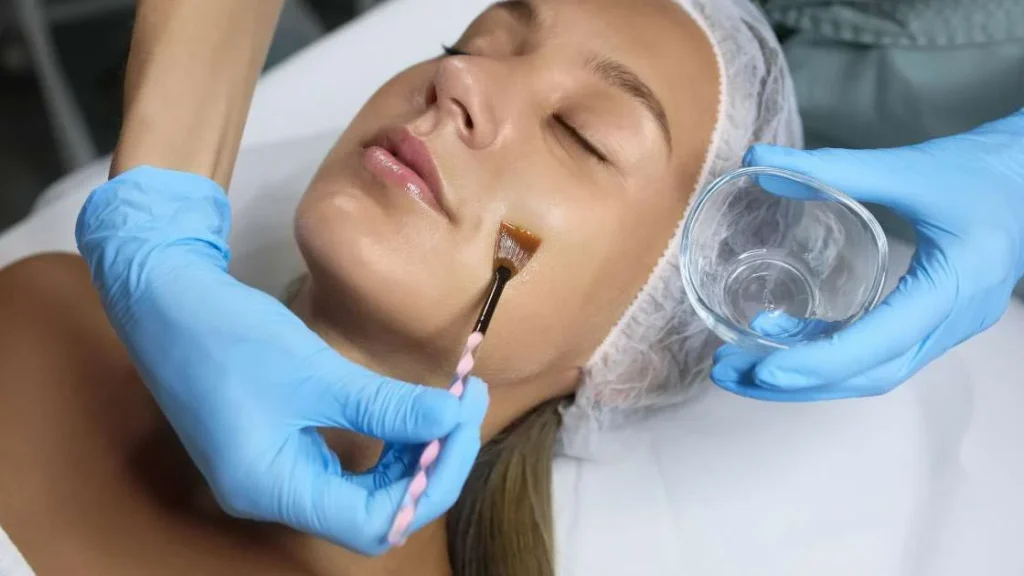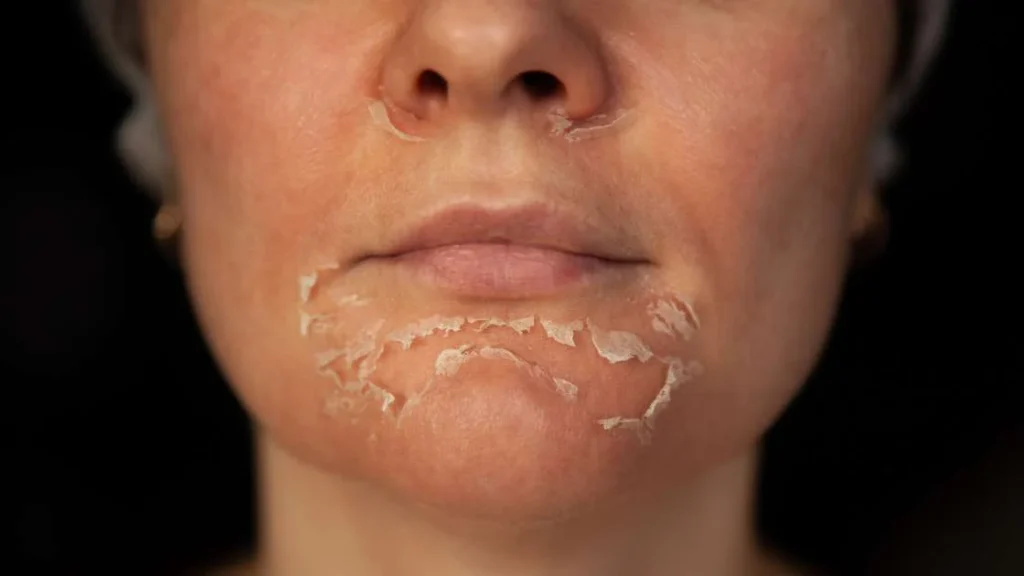Dreaming of smoother, more radiant skin? A chemical peel might be the perfect solution, but the secret to long-lasting results lies in how you care for your skin during recovery. Whether you’ve chosen a light, medium, or deep chemical peel, knowing what to expect post-treatment can make a huge difference in the healing process. In this guide, we’ll cover everything you need to know about the chemical peel recovery process, offering expert tips and advice to help you achieve glowing, youthful skin.
What is a Chemical Peel?
A chemical peel is a non-invasive facial treatment designed to rejuvenate your skin by removing its outer layers using a chemical solution. This controlled exfoliation process reveals new, healthier skin underneath. Depending on the type of peel, it can address a variety of concerns:
- Light Peels: Ideal for minor texture issues, dullness, and fine lines. Light peels use mild acids like alpha hydroxy acids (AHAs) such as glycolic acid to provide gentle exfoliation.
- Medium Peels: Target moderate imperfections like acne scars, deeper pigmentation, and wrinkles. These often use trichloroacetic acid (TCA) for a more noticeable result.
- Deep Peels: Best suited for more severe skin issues such as deep wrinkles, pronounced scarring, and sun damage. These typically involve phenol and provide the most dramatic results but require a longer recovery time.
The right type of peel for you will depend on your specific skin concerns and the depth of results you are looking to achieve. But no matter which peel you choose, understanding the recovery process is essential for a smooth, successful outcome.
The Recovery Process Explained: What to Expect and When
The chemical peel recovery process varies depending on the depth of your peel. Here’s a detailed breakdown of what to expect during each stage and how to care for your skin to ensure the best results.
Day 1: Post-Treatment Care and Immediate Reactions
- Light Peels: Expect mild redness and a sensation similar to a sunburn. The skin may feel tight and slightly sensitive. Redness may last for a few hours to a day, with some minor flaking possible.
- Medium Peels: You may experience more pronounced redness and swelling, along with warmth in the treated area. The skin might have a slight stinging sensation that can last up to 48 hours.
- Deep Peels: Significant redness, swelling, and tenderness are normal. A white frost (chemical frosting) may form on the skin during the procedure, which fades within a few hours. The treated area will look and feel like a severe sunburn.
Care Tips:
- Gentle Cleansing: Use a mild, hydrating cleanser twice a day, like those containing aloe vera or chamomile extract, which can soothe irritated skin.
- Moisturize Frequently: Apply a fragrance-free moisturizer, such as petrolatum-based products or ceramide-rich creams, to lock in moisture.
- Sun Protection: Use a broad-spectrum SPF 30 or higher even indoors, as your skin is highly sensitive to UV rays. Consider a mineral sunscreen with zinc oxide or titanium dioxide for maximum protection.
Day 2-3: Peeling Begins
- Light Peels: Mild flaking and tightness; peeling is generally minimal. You may notice small, dry patches around areas like the nose and mouth.
- Medium Peels: Noticeable peeling starts, especially around the mouth and nose. Your skin might feel dry and tight, and the peeling gradually spreads outward to the rest of the face.
- Deep Peels: Swelling starts to subside, but heavy peeling begins, revealing a pink layer of fresh skin underneath. The peeling will be more intense and may be accompanied by a burning sensation.
Care Tips:
- Hands Off!: Resist the urge to pick or peel at your skin. Letting it shed naturally prevents scarring and hyperpigmentation.
- Hydration is Key: Use products with ingredients like hyaluronic acid to lock in moisture and keep your skin comfortable. Opt for serums with simple formulations to avoid irritation.
- Cold Compresses: For discomfort or swelling, apply a cold compress wrapped in a soft cloth for 10 minutes at a time. This can help reduce inflammation and provide relief from stinging.
Day 4-7: Intense Peeling and Healing
- Light Peels: Peeling subsides, revealing smoother, more even skin. Your skin tone may appear brighter and more even, with a subtle glow.
- Medium Peels: Peeling is at its peak. Skin might look pink or red underneath the shedding skin, which is normal as new skin cells regenerate.
- Deep Peels: Heavy peeling continues. Underneath, the new skin may appear raw and very sensitive, with areas of redness. Swelling should have mostly subsided by the end of this period.
Care Tips:
- Keep Moisturizing: Products containing ceramides, glycerin, and squalane can help rebuild the skin’s natural barrier, maintaining hydration without clogging pores.
- Avoid Active Ingredients: Steer clear of exfoliants, retinol, or any harsh ingredients until the skin is fully healed, as they can cause irritation and disrupt the healing process.
- Stay Cool: Avoid activities that make you sweat, like strenuous exercise, as this can irritate sensitive skin and delay healing. Sweating can also introduce bacteria to the treated areas, increasing the risk of infection.
Week 2: New Skin Emerges
- Light Peels: Your skin should be fully healed with a noticeable improvement in texture and radiance. It’s safe to start using gentle makeup if needed.
- Medium Peels: Pinkness will fade gradually, and skin will start to regain its natural tone. You may notice a more even skin tone and softer texture.
- Deep Peels: Fresh skin is still forming, and redness may persist, but the texture will be significantly smoother. At this stage, it’s important to continue being gentle with your skincare routine.
Care Tips:
- Introduce Gentle Products: Gradually reintroduce non-active serums, like vitamin C for brightening, as long as your skin tolerates it without irritation.
- Continue Using Sunscreen: Even after the skin has healed, daily SPF is a must to protect against hyperpigmentation. Opt for products designed for sensitive or post-procedure skin.
- Keep Hydrating: Opt for rich moisturizers like those containing niacinamide, which can help calm redness and support the skin barrier.

Expert Tips for a Smooth Chemical Peel Recovery
- Hydrate Inside and Out: Drink plenty of water to keep your skin hydrated from the inside, and use moisture-rich products for external hydration. Ingredients like panthenol can also help retain moisture.
- Stay Out of the Sun: Direct sunlight can cause irritation and compromise your results, so avoid sun exposure as much as possible during the first few weeks post-peel.
- Avoid Touching Your Face: Touching your healing skin can introduce bacteria and delay the recovery process. Always wash your hands before applying any skincare.
- Patience is Key: Trust the process and avoid trying to speed up peeling; your skin needs time to regenerate, and trying to accelerate the process can cause more harm than good.
Read also: How Long Does Botox Last?
Potential Side Effects and How to Address Them
- Redness and Sensitivity: Redness is common after peels, especially deep ones. Use calming serums and avoid any harsh treatments during this time. Consider products with centella asiatica or green tea extract for soothing.
- Risk of Hyperpigmentation: Dark spots can occur if you don’t protect your skin from the sun. Apply SPF diligently to minimize this risk, and consider using a vitamin C serum to help brighten any residual pigmentation once the skin is fully healed.
- Infections: Keep your hands clean and avoid touching your face to prevent infections. If you notice excessive redness or swelling, consult your dermatologist.
- Scarring Risk: Picking at peeling skin can lead to scarring, especially with medium or deep peels. Use a healing ointment as recommended by your skincare provider if you notice any areas that look raw or irritated.
When to Contact a Professional
- If Redness or Swelling Persists: Extended irritation may indicate an allergic reaction or sensitivity. A professional can recommend treatment options to soothe the skin.
- Signs of Infection: Such as oozing, pus formation, or an increase in redness and heat around the treated area.
- Concerns About Scarring: A dermatologist can offer treatments like LED light therapy or prescription creams to minimize any lasting marks.
Conclusion: Achieve a Smooth, Glowing Recovery
With the right aftercare and patience, the chemical peel recovery process can transform your skin, leaving it smoother, more even-toned, and youthful. Remember, each type of peel has a unique recovery time, but proper care is the constant that ensures beautiful results. If you’re ready to embark on this skincare journey, consult with a licensed professional to find the perfect peel for your skin needs.
Ready to experience your best skin yet? Contact our clinic for a consultation and let us help you uncover your natural glow!


